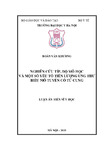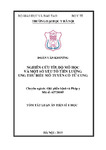
Please use this identifier to cite or link to this item:
http://dulieuso.hmu.edu.vn/handle/hmu/2024| Title: | Nghiên cứu típ, độ mô học và một số yếu tố tiên lượng ung thư biểu mô tuyến cổ tử cung |
| Authors: | Đoàn Văn, Khương |
| Advisor: | GS.TS. Nguyễn, Vượng PGS.TS. Trịnh Quang, Diện |
| Keywords: | 62720105;Giải phẫu bệnh và pháp y |
| Abstract: | THÔNG TIN TÓM TẮT VỀ NHỮNG KẾT LUẬN MỚI CỦA . LUẬN ÁN TIẾN SĨ. Nghiên cứu mô tả có theo dõi dọc 199 bệnh nhân ung thư cổ tử cung có chẩn đoán mô bệnh học là ung thư biểu mô tuyến (UTBMT) tại Bệnh viện K Trung ương trong 4 năm (từ 1/1999 đến 12/1912). Luận án là công trình kết hợp giữa giải phẫu bệnh học và lâm sàng học của UTBMT cổ tử cung (một típ ung thư ít gặp, chỉ chiếm 10-15% ung thư cổ tử cung). Lần đầu tiên tại Việt Nam, một nghiên cứu xác định típ mô bệnh học và độ mô học UTBMT cổ tử cung với số lượng lớn (199 trường hợp) cũng như chẩn đoán giai đoạn lâm sàng theo FIGO và TMN và theo dõi thời gian sống thêm sau điều trị. Các kết quả chính: Gặp 4 típ mô bệnh học UTBMT (nhày: 72,9%, dạng nội mạc tử cung: 17,6 %, tế bào sáng: 9% và mới xâm nhập: 0,5%), các biến thể của UTBMT nhày (cổ trong: 52,2%, ruột: 19,5%, tế bào nhẫn: 2,1%, sai lệch tối thiểu: 6,2%, tuyến nhung mao: 20,6%), các độ mô học (biệt hóa cao: 31,7%, biệt hóa vừa: 47,7%, biệt hóa thấp: 20,6%). Xác định giai đoạn lâm sàng (IIB-IIIB: 47,7%, IB: 26,1%, IIA: 19,2%, IVB: 6,5% và IA: 0,5%). Tỉ lệ sống thêm toàn bộ 5 năm sau điều trị (TLSTTB5NSĐT) tương đối thấp (46,8%), 1 năm: 84%; 2 năm: 76,5%; 3 năm: 66,5%; 4 năm: 61,6%. Các típ mô bệnh học ảnh hưởng đến TLSTTB5NSĐT không có ý nghĩa thống kê. Trái lại, độ mô học của u, giai đoạn bệnh ảnh hưởng đến TLSTTB5NSĐT có ý nghĩa thống kê. Cụ thể: TLSTTB5NSĐT của các bệnh nhân ở típ: mới xâm nhập: 100%; nhày: 57%; dạng nội mạc tử cung: 39,4%; tế bào sáng: 24,6%; típ nhày biến thể tuyến nhung mao: 73,5%, sai lệnh tối thiểu: 57,1%, cổ trong: 54,6%, tế bào nhẫn: 50%, ruột: 44,1%. TLSTTB5NSĐT của các bệnh nhân giảm dần theo độ mô học: biệt hóa cao (69,1%), biệt hóa vừa (44,8%), biệt hóa thấp (38,9%). TLSTTB5NSĐT ở các bệnh nhân ở giai đoạn IA và IB là tuyệt đối (100%), giai đoạn IIA rất cao (96,3%), giai đoạn IIB-IIIB thấp (22,2%) và rất thấp ở giai đoạn IVB (10,7%). Từ kết quả nghiên cứu nhấn mạnh tầm quan trọng của việc: xác định típ mô bệnh học, độ mô học, giai đoạn bệnh và theo dõi sau điều trị của các bệnh nhân UTBMT cổ tử cung; đồng thời giúp cho các thầy thuốc lâm sàng áp dụng vào điều kiện thực tế của Việt Nam để đề ra phương pháp điều trị thích hợp và tiên lượng bệnh thêm chính xác.. SUMMARY INFORMATION OF NEW CONCLUSION DOCTORAL DISSERTATION. NEW CONCLUSION OF THE THESIS:. The descriptive longitudinal observation of 199 patients with cervical cancer histopathological diagnosed as adenocarcinoma (AC) at the Vietnam National Cancer Hospital for 4 years (from 1/1999 to 12/1912) The dissertation is the combination between pathology and clinical data of cervical AC (a rare type, accounting for 10-15% of cervical cancer). In Vietnam, the first study identified histopathological type and histopathologic grading of cervical AC with large quantities (199 cases) as well as clinical diagnosis according to FIGO and TMN stage, and follow up survival after treatment. Mainly results: identifying 4 histopathological type (mucinous type: 72.9%; endometrioid type: 17.6 %; clear cell type: 9%; early invasive type: 0.5%). The variations of mucinous AC (endocervical: 52.2%; intestinal: 19.5%; Signet-ring cell: 2.1%, minimal deviation: 6.2%, villoglandular: 20.6%). Histopathologic grading (moderately differentiated: 47.7%, well-differentiated: 31.7%, and poorly differentiated: 20.6%). Clinical stage are IIB-IIIB: 47.7%; IB: 26.1%; IIA: 19.2%; IVB: 6.5%; IA: 0.5%. 5-year survival rate (YSR) is relatively low rate (46.8%), 1- YSR: 84%; 2- YSR: 76.5%; 3- YSR: 66.5%; 4- YSR: 61.6%. The histopathological types affect the 5-YSR has no significance deffirence. In contrast, histopathologic grading, clinical stage (TMN and FIGO) affecting 5-YSR are markedly significance deffirence. Specifically, 5-YSR of early invasive AC is the highest (100%). Other types are lower survival rate: mucinous type (57%); endometrioid type (39.4%); clear cell type (24.6%). 5-YSR of mucinous AC, villoglandular variant is the highest (73.5%). 5-YSR of other variants are lower: minimal deviation (57.1%); endocervical (54.6%); signet-ring cell (50%); intestinal (44.1%). 5-YSR of histopathologic grades are descending: well-differentiated (69.1%), moderately differentiated (44.8%), and poorly differentiated (38.9% ). 5-YSR of stage IA and IB patients are absolute (100%), stage IIA is very high (96.3%), stage IIB-IIIB is low (22.2 %), and stage IVB is very low (10.7%). These finding suggested the importance of identification of histopathological type, histopathologic grading, clinical stage and follow up patients after treatment cervical AC are to help clinicians for applying in practical conditions of Vietnam to set appropriate treatment stragies and more accurate prognostic factors. Scientific Supervisors. |
| URI: | http://dulieuso.hmu.edu.vn//handle/hmu/2024 |
| Appears in Collections: | Luận án (nghiên cứu sinh) |
Files in This Item:
| File | Description | Size | Format | |
|---|---|---|---|---|
| 135_LA- Khuong.pdf Restricted Access | 5.11 MB | Adobe PDF |  Sign in to read | |
| 135_24- Khuong.pdf Restricted Access | 390.84 kB | Adobe PDF |  Sign in to read |
Items in DSpace are protected by copyright, with all rights reserved, unless otherwise indicated.